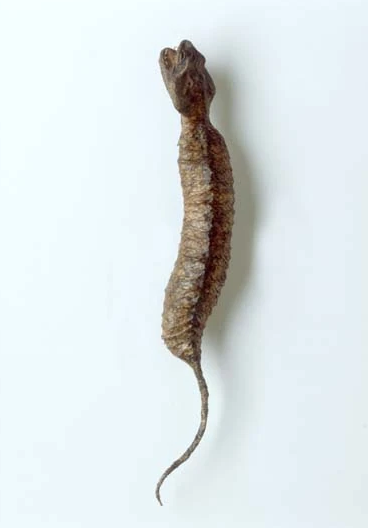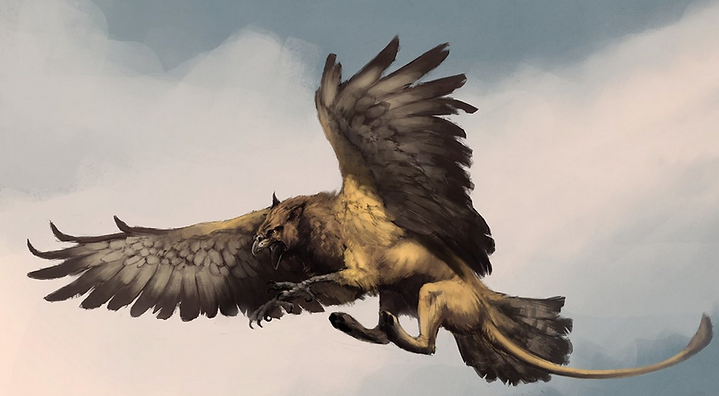Cryptids
Tsuchinoko: Japanese Snake-Like Being

A very realistic looking paper model of a Tsuchinoko by Hajime Emoto
Tsuchinoko are a snake-like cryptid from Japan, said to be about the size of a cat with scaly skin and viper-like fangs.
Description of the Tsuchinoko
A drawing of a Tsuchinoko. Photo: Wikipedia
Tsuchinoko, also known as nozuchi or bachihebi are a snake-like cryptid from Japan.
Tsuchinoko are a type of yokai that have a short, stumpy, snake-like appearance, with a body shape that resembles a hammer or a mallet head without a handle.
They have scaly skin in various earth tones with light-colored bellies, and viper-like fangs carrying a lethal venom. Unlike typical snakes, they have eyelids. These creatures can range in size from thirty to eighty centimeters long and are often compared to beer bottles due to their shape and color.
These creatures can be found throughout Japan and are most active during the day from spring through fall. During the winter, they hibernate in nests that they create in holes along wooded riverbanks. Tsuchinoko are known to make a “chee” sound and snore while sleeping.
When they are young, Tsuchinoko feed on insects, but as they grow, they begin to consume larger prey, such as frogs, mice, and sometimes even cats or dogs. Despite their small size, Tsuchinoko are capable of consuming vast amounts of food. They are also attracted to the smell of miso, dried squid, and burning hair, and have a fondness for sake.
Despite their unusual shape, Tsuchinoko are incredibly agile and can move like an inchworm. Their most well-known behavior is their ability to roll and tumble about. Tsuchinoko are also skilled jumpers, able to jump as far as two to five meters.
They can roll sideways like a log, tumble vertically from tip-to-tail, or even swallow their tail to form a ring and roll like a wheel. In this way they are similar to the American Hoop Snake.
In more whimsical accounts of the Tsuchinoko they are said to possess the gift of speech and a tendency to tell falsehoods. They are also rumored to have a liking for alcoholic beverages.
Origin of the Tsuchinoko
An Artist’s impression of the Tsuchinoko. Photo: Happy Serpent
Since prehistoric times, Japanese folklore has included creatures resembling Tsuchinoko. Pottery and stone tools from the Jomon period have been discovered featuring motifs resembling short, stumpy snakes.
During the Edo Period, numerous folkloric encyclopedias documented venomous yokai with rolling, snake-like qualities, such as the nozuchi and tsuchi korobi.
The Kojiki, which is the oldest recorded collection of Japanese legends and tales, includes a reference to the Tsuchinoko.
Reported Sightings of the Tsuchinoko
A video telling of the legend of the Tsuchinoko
In the 1970s, Tsuchinoko sightings and reports of live captures garnered national attention, causing a widespread “tsuchinoko boom” and inciting a hunt for these creatures all over Japan.
This craze was further fueled by numerous eyewitness accounts, blurry photographs, and talk show specials, which helped establish Tsuchinoko as a household name.
Since then, Tsuchinoko has continued to be a topic of great interest among cryptozoologists, with monetary rewards sometimes offered to individuals who can provide photographic or physical evidence of their existence.
An annual Tsuchinoko Festival takes place on May 3rd in Higashishirakawa, Gifu prefecture, where the origins of the legend can be traced. The festival involves participants hunting for a tsuchinoko, and a prize of 1,280,000 yen (US$11,449) is awarded to anyone who manages to find one.
In the past, the government of Yoshii, Okayama, offered a 20 million yen (US$200,000) reward for capturing a tsuchinoko.
In June 1994, a man named Kazuaki Noda and his wife claimed to have come across a massive snake with a thick body resembling a beer bottle, and a head that looked like that of a tortoise. Similarly, in May 8th, 2000, a farmer named Sugie Tanaka reported seeing two metallic-colored snakes with “tails like rats.”
In June of the same year, a woman named Mitsuko Arima spotted a tsuchinoko swimming in a river.
She recounted her experience, saying, “I was surprised. I just pointed at it and asked ‘Who are you? Who are you?’ It didn’t answer me but just stared. It had a round face and didn’t take its eyes off me. I can still see the eyes now. They were big and round, and it looked like they were floating on the water. I’ve lived over 80 years, but I’d never seen anything like that in my life.”
Have you ever seen a Tsuchinoko? Tell us about it in the comments.
If you enjoyed learning about the Tsuchinoko you might be interested in some other reptilian cryptids such as the grootslang or the Hoop Snake.
Cryptids
Mothman SIghted Before 2007 Bridge Collapse in Minnesota

The aftermath of the I-35w Bridge Collapse in 2007. Image: Wikipedia
Just like the infamous Silver Bridge Mothman sightings, witnesses claim seeing a strange, 7ft tall flying humanoid in the weeks before the collapse of the I-35W bridge in 2007.
The Collapse of the I-35W Bridge
The I-35W Mississippi River bridge (also known as Bridge 9340) was a large bridge in Minneapolis, Minnesota, that carried Interstate 35W over the river. It was built in 1967 and was one of the busiest bridges in Minnesota, with thousands of cars using it every day.
Sadly, on August 1, 2007, during the evening rush hour when hundreds of people were driving home from work, something terrible happened. The bridge suddenly collapsed, causing a lot of damage. Sadly, 13 people died, and 145 were injured.
Investigators later found out that a part of the bridge, called the gusset plate, had failed. The gusset plate was worn and the stress of the extra cars on the bridge caused it to break apart.
Right after the collapse, people and emergency workers from nearby areas rushed to help. They worked hard to rescue anyone who was trapped and to take care of the injured.
The Minnesota Department of Transportation quickly made plans to build a new bridge called the I-35W Saint Anthony Falls Bridge. They finished building it just over a year later, and it opened in September 2008.
Connections to the Silver Bridge Collapse
The Silver Bridge Collapse
For many cryptid enthusiasts, hearing of a bridge collapse immediately brings Mothman to mind. The Silver Bridge was a suspension bridge spanning the Ohio River, connecting Point Pleasant, West Virginia, and Gallipolis, Ohio. On December 15, 1967, during rush hour, the bridge suddenly collapsed, sending cars and people plunging into the icy waters below. The disaster claimed the lives of 46 individuals, making it one of the deadliest bridge collapses in American history.
In the months leading up to the tragedy, residents of Point Pleasant reported sightings of a mysterious creature dubbed the “Mothman.” Described as a large, winged humanoid with glowing red eyes, the Mothman sightings fueled speculation and fear in the community.
Following the Silver Bridge collapse, some people began to link the sightings of the Mothman to the disaster, suggesting that the creature was a harbinger of impending doom. This connection led to the Mothman becoming a legendary figure in cryptozoology and popular culture.
Both the Silver Bridge collapse and the I-35w collapse were caused by structural failures in the bridges. In the case of the Silver Bridge, the collapse was attributed to a single eyebar in the suspension chain that failed due to metal fatigue. In the I-35W collapse, a design flaw in the bridge’s gusset plates, combined with increased weight from construction materials and traffic, led to the catastrophic failure.
Mothman Sightings Connected to the I-35W Bridge Collapse
Dark Reocrds covers the I-35w brdge collapse
The I-35w collapse Mothman sightings differ from the Silver Bridge Mothman sightings in their frequency. Dozens of people around Pleasant Point reported strange sightings and unexplained paranormal or extraterrestrial activity in the months leading up to the Silver Bridge collapse. The sightings surrounding the I-35w collapse were mush less common.
On August 10, 2007, George Noory hosted the “Coast to Coast AM” program, where he spoke to several callers sharing their encounters with cryptids. Among these calls was one reporting a sighting on June 27th near Stewartville, Minnesota. The caller described seeing a 7-foot-tall, winged humanoid creature with a massive wingspan, roughly the width of her Ford vehicle. The sighting occurred approximately 90 miles from the I-35w bridge, just over a month before the bridge collapse.
There are references to multiple other sightings online but they seem to have been removed from the internet. A WIRED article from the time talks of numerous blog posts on the topic but the link no longer works. This article by Singular Fortean also alludes to their being multiple sightings but doesn’t provide references.
Skepticism
So it seems we just have the one account to work with here. It’s possible that the George Noory’s caller was just someone making up a story and looking for a bit of attention. The fact that the account didn’t come out until after the collapse of the I-35w bridge does take from its credibility.
It is also possible that the caller simple saw a large crane or other bird and misidentified their memory as the mothman following the bridge collapse.
What if it was Mothman?
If it was Mothman that was seen before the collapse of the I-35w bridge it leads us to more questions than answers. Is this Mothman the same creature that was seen before the Silver Bridge collapse? Could Mothman actually be a species of creature that is drawn to human disasters, particularly bridge collapses?
Tell us your theories in the comments.
If you enjoyed reading about Mothman and the I-35w bridge collapse you might be interested in our article on the original Mothman story or the blackbird of Chernobyl.
Cryptids
The Awful

The Awful cryptid as described by Vermont residents in 1925
In 1923, several residents of Berkshire and Richford, Vermont reported seeing a creature resembling a griffin, with a 20 foot wingspan and a serpentine tail.
“The Awful” Cryptid Sightings of 1925
Berkshire and Richford, Vermont are peaceful countryside towns located between Lake Champlain and Lake Memphremagog, near the Canadian Province of Quebec.
In 1925 several residents of these towns reported encounters with an unusual flying creature.
The creature was described as being similar to the mythical Griffin, with a grayish color, a 20-foot wingspan, a snake-like tail, and big claws capable of holding a medium sized dog. These strange sightings caused panic among the locals who came to dub the creature “the Awful”.
The first sightings of the mysterious creature were reported by two sawmill workers in Richford. As they crossed the main street bridge, they saw a very large beast on the nearby rooftop of the Boright building, glaring at them. According to the tale, one of the men was so scared that he had a heart attack out of fear. He had to be carried home but eventually recovered. However, for weeks afterward, he had nightmares about the creature, waking up his family with screams during the night.
In the following months, locals kept reporting sightings of this mysterious creature, causing fear and panic among residents. Farmers shared stories of it flying over their fields, and others saw it landing on their house rooftops. One resident, Oella Hopkins, experienced this when she was hanging laundry outside. The family dog got upset and started barking, and when Oella looked, she saw the creature, known as The Awful, perched on her farmhouse roof, staring at her. Terrified, Oella ran inside and hid under her bed for hours.
Later Sightings of “The Awful”
By the end of 1925, sightings of the creature became less frequent and almost stopped completely by 1928. Even though people thought it had disappeared, some locals claimed to see it every now and then since the 1920s. One such person was Lisa Maskell from Montgomery, who said she spotted the creature near Trout River when she was a child. When she saw a drawing of a pterodactyl later on, she thought it looked like the creature she saw and believed it resembled The Awful.
In 2006, there were a few new reports suggesting that The Awful might have returned to Northern Vermont. In October 2006, a person wrote in the County Courier about a respected person in Richford who saw the creature suddenly appear and grab a big black crow from a pine tree. The witness was surprised and said the creature flew around his house three times.
After this article, more people shared sightings. A woman remembered seeing the monster when she was about ten. It was in a tree near the Trout River, watching them with its strange beak, reminding her of a pterodactyl.
A dowser named Edith Green said people in Richford have been nervous about the creature for a long time.
An older man mentioned that the creature has been seen often in the Gibou area for the past 25 years, even recently. Locals usually leave it alone, and it leaves them alone, with a few exceptions.
A resident of East Richford said the creature has been spotted recently around the Slide Road area. He mentioned you can often hear it before seeing it, making a strange, low screaming sound and the flapping of its large wings when it’s close.
Despite its scary appearance, the creature was never known to attack people; it seemed more like it was just watching. There’s one account mentioning it flying over Berkshire Field near Lost Nation Road and appearing to hold a baby or a small animal, although it’s more likely to have been an animal.
William DeFalco covers the story of The Awful
Possible Explanations for the Awful
Assuming the reports of the Awful are not just a hoax or an old wives tale what else could be going on here? It’s possible that soe type of rare, large bird is lurking in the wilds of Vermont and is only seen very rarely due to a lack of numbers. The Awful could simple have been a particularly large owl or Eagle.
If paranormal in origin, the Awful does bear a small resemblence to the Mothman of West Virginia. Perhaps it continues to lurk in the shadows, waiting to come our and warn residents of impending doom.
What do you think about the Awful? Tell us your theories in the comments.
If you enjoyed learning about the Awful you might also be interested in the Lechuza, a strange owl-like creature or the Prime Hook Swamp Monster.
-

 Ghosts2 years ago
Ghosts2 years agoZozo: The Ouija Board Demon
-

 Space2 years ago
Space2 years agoScientists claim to have found the answer what existed before the Universe
-

 Ghosts2 years ago
Ghosts2 years agoOld Coot of Mount Greylock
-
Archaeology1 year ago
New discoveries at Ekʼ Balam during conservation works
-

 General3 years ago
General3 years agoUC San Francisco engaging in horrifying experiments, organ harvesting of live babies in the name of “science”
